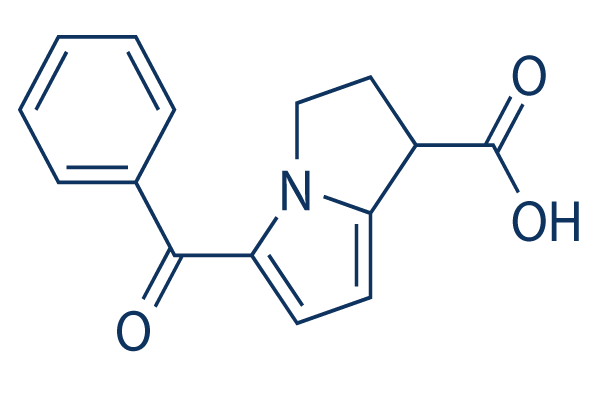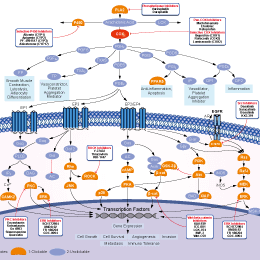
- Bioactive Compounds
- By Signaling Pathways
- PI3K/Akt/mTOR
- Epigenetics
- Methylation
- Immunology & Inflammation
- Protein Tyrosine Kinase
- Angiogenesis
- Apoptosis
- Autophagy
- ER stress & UPR
- JAK/STAT
- MAPK
- Cytoskeletal Signaling
- Cell Cycle
- TGF-beta/Smad
- Compound Libraries
- Popular Compound Libraries
- Customize Library
- Clinical and FDA-approved Related
- Bioactive Compound Libraries
- Inhibitor Related
- Natural Product Related
- Metabolism Related
- Cell Death Related
- By Signaling Pathway
- By Disease
- Anti-infection and Antiviral Related
- Neuronal and Immunology Related
- Fragment and Covalent Related
- FDA-approved Drug Library
- FDA-approved & Passed Phase I Drug Library
- Preclinical/Clinical Compound Library
- Bioactive Compound Library-I
- Bioactive Compound Library-Ⅱ
- Kinase Inhibitor Library
- Express-Pick Library
- Natural Product Library
- Human Endogenous Metabolite Compound Library
- Alkaloid Compound LibraryNew
- Angiogenesis Related compound Library
- Anti-Aging Compound Library
- Anti-alzheimer Disease Compound Library
- Antibiotics compound Library
- Anti-cancer Compound Library
- Anti-cancer Compound Library-Ⅱ
- Anti-cancer Metabolism Compound Library
- Anti-Cardiovascular Disease Compound Library
- Anti-diabetic Compound Library
- Anti-infection Compound Library
- Antioxidant Compound Library
- Anti-parasitic Compound Library
- Antiviral Compound Library
- Apoptosis Compound Library
- Autophagy Compound Library
- Calcium Channel Blocker LibraryNew
- Cambridge Cancer Compound Library
- Carbohydrate Metabolism Compound LibraryNew
- Cell Cycle compound library
- CNS-Penetrant Compound Library
- Covalent Inhibitor Library
- Cytokine Inhibitor LibraryNew
- Cytoskeletal Signaling Pathway Compound Library
- DNA Damage/DNA Repair compound Library
- Drug-like Compound Library
- Endoplasmic Reticulum Stress Compound Library
- Epigenetics Compound Library
- Exosome Secretion Related Compound LibraryNew
- FDA-approved Anticancer Drug LibraryNew
- Ferroptosis Compound Library
- Flavonoid Compound Library
- Fragment Library
- Glutamine Metabolism Compound Library
- Glycolysis Compound Library
- GPCR Compound Library
- Gut Microbial Metabolite Library
- HIF-1 Signaling Pathway Compound Library
- Highly Selective Inhibitor Library
- Histone modification compound library
- HTS Library for Drug Discovery
- Human Hormone Related Compound LibraryNew
- Human Transcription Factor Compound LibraryNew
- Immunology/Inflammation Compound Library
- Inhibitor Library
- Ion Channel Ligand Library
- JAK/STAT compound library
- Lipid Metabolism Compound LibraryNew
- Macrocyclic Compound Library
- MAPK Inhibitor Library
- Medicine Food Homology Compound Library
- Metabolism Compound Library
- Methylation Compound Library
- Mouse Metabolite Compound LibraryNew
- Natural Organic Compound Library
- Neuronal Signaling Compound Library
- NF-κB Signaling Compound Library
- Nucleoside Analogue Library
- Obesity Compound Library
- Oxidative Stress Compound LibraryNew
- Plant Extract Library
- Phenotypic Screening Library
- PI3K/Akt Inhibitor Library
- Protease Inhibitor Library
- Protein-protein Interaction Inhibitor Library
- Pyroptosis Compound Library
- Small Molecule Immuno-Oncology Compound Library
- Mitochondria-Targeted Compound LibraryNew
- Stem Cell Differentiation Compound LibraryNew
- Stem Cell Signaling Compound Library
- Natural Phenol Compound LibraryNew
- Natural Terpenoid Compound LibraryNew
- TGF-beta/Smad compound library
- Traditional Chinese Medicine Library
- Tyrosine Kinase Inhibitor Library
- Ubiquitination Compound Library
-
Cherry Picking
You can personalize your library with chemicals from within Selleck's inventory. Build the right library for your research endeavors by choosing from compounds in all of our available libraries.
Please contact us at [email protected] to customize your library.
You could select:
- Antibodies
- Bioreagents
- qPCR
- 2x SYBR Green qPCR Master Mix
- 2x SYBR Green qPCR Master Mix(Low ROX)
- 2x SYBR Green qPCR Master Mix(High ROX)
- Protein Assay
- Protein A/G Magnetic Beads for IP
- Anti-Flag magnetic beads
- Anti-Flag Affinity Gel
- Anti-Myc magnetic beads
- Anti-HA magnetic beads
- Poly FLAG Peptide lyophilized powder
- Protease Inhibitor Cocktail
- Protease Inhibitor Cocktail (EDTA-Free, 100X in DMSO)
- Phosphatase Inhibitor Cocktail (2 Tubes, 100X)
- Cell Biology
- Cell Counting Kit-8 (CCK-8)
- Animal Experiment
- Mouse Direct PCR Kit (For Genotyping)
- New Products
- Contact Us
Ketorolac
Ketorolac is a non-selective COX inhibitor of COX-1 and COX-2 with IC50 of 1.23 μM and 3.50 μM, respectively.

Ketorolac Chemical Structure
CAS: 74103-06-3
Selleck's Ketorolac has been cited by 2 publications
Purity & Quality Control
Batch:
Purity:
100%
100
Ketorolac Related Products
Signaling Pathway
Choose Selective COX Inhibitors
Biological Activity
| Description | Ketorolac is a non-selective COX inhibitor of COX-1 and COX-2 with IC50 of 1.23 μM and 3.50 μM, respectively. | ||||
|---|---|---|---|---|---|
| Features | A COX-1 preferential inhibitor among currently marked nonsteroidal anti-inflammatory drugs (NSAIDs). | ||||
| Targets |
|
| In vitro | ||||
| In vitro | (R, S)-, (S)-, and (R)-Ketorolac inhibit both isoforms of COX in recombinant rat and human enzyme systems, and similar as inhibitors of rat COX (rCOX) and human COX (hCOX) under the conditions used. (R, S)-Ketorolac inhibits rat COX-1, rat COX-2, human COX-1 and human COX-2 with IC50 of 0.27 μM, 2.06 μM, 1.23 μM and 3.50 μM, respectively. The (S) enantiomer of Ketorolac with IC50 of 0.10 μM for rat COX-1 is approximately twice as potent as the racemate, whereas the (R)-enantiomer with IC50 of > 100 μM is virtually without activity. [1] Ketorolac shows inhibition of eicosanoid formation in HEL cells (COX-1) and LPS-stimulated Mono Mac 6 cells (COX-2) with IC50 of 0.025 μM and 0.039 μM, respectively, but does not significantly inhibit NO accumulation in supernatants of LPS-stimulated RAW 264.7 cells up to 300 μM. [2] Ketorolac significantly inhibits thymidine incorporation of human osteoblasts (hOBs) upon 24 hours treatment in a dose-dependent manner, and inhibits proliferation and arrests cell cycle at G0/G1 phase in hOBs. [3] | |||
|---|---|---|---|---|
| Kinase Assay | Inhibition of Prostaglandin Formation | |||
| Recombinant COX-1 and COX-2 from rat (rCOX) and human (hCOX) expressed in a baculovirus system are purified and reconstituted with 2 mM phenol and 1 μM hematin. Then the cyclooxygenase activity is measured using a radiometric assay, and the specific activity of the final enzyme preparations used is between 20,000 and 35,000 units. Ketorolac (2 -15 μL) are diluted in DMSO and preincubated with the appropriate recombinant COX (3 -15 ng) at a final concentration of 0.01 to 1000 μM in a reaction mixture (150 μL) containing 50 mM Tris-HCl buffer (pH 7.9), 2 mM EDTA, 10% glycerol, 2 mM phenol, and 1 μM hematin for 10 minutes. The reaction is initiated by addition of [14C]arachidonic acid (50–60 mCi/mmol in a final concentration of 20 μM) and is terminated 45 seconds later by the addition of 100 μL of 0.2 N HCl and 750 μL of distilled water. The total reaction volume is then applied to a 1 mL C18 Sep-pak column that has previously been washed with 2 mL of methanol followed by 5 mL of deionized water. Oxygenated products are eluted with 3 mL of a mixture of acetonitrile/water/acetic acid (50:50:0.1, v/v/v) and quantified by liquid scintillation spectroscopy. | ||||
| Cell Research | Cell lines | Primary human osteoblasts cell lines | ||
| Concentrations | Dissolved in DMSO, final concentration ~0.1 mM | |||
| Incubation Time | 24 hours | |||
| Method | Human osteoblasts cells are exposed to Ketorolac for 24 hours. Thymidine incorporation is assessed by the TopCount Microplate Scintillation and Luminescence Counters through adding [3H]-thymidine to cultures 4 hours prior to harvesting. Cell cycle distribution is determined by using propidium iodide in flow cytometer, and cell apoptosis or necrosis is detected using the Annexin V-FITC Apoptosis Detection Kit. | |||
| In Vivo | ||
| In vivo | (R, S)-Ketorolac is significantly more potent than indomethacin or diclofenac sodium in tests of acetic acid-induced writhing, carrageenan-induced paw hyperalgesia, and carrageenan-induced edema formation in rats, with ID50 of 0.24, 0.29 and 0.08 mg/kg, respectively. [1] Ketorolac produces significant inhibition of COX-1 activity and gastric PG synthesis with doses of ≥1 mg/kg inhibiting COX-1 activity by 95% and gastric PG synthesis by >88%. Ketorolac does not significantly affect COX-2 activity at doses of ≤3 mg/kg, but at doses of 10 and 30 mg/kg, Ketorolac produces significant inhibition of COX-2 activity by 75% and 91%, respectively. Ketorolac causes gastric damage in rats only at doses that inhibits both COX-1 and COX-2, or when given with a COX-2 inhibitor. [4] | |
|---|---|---|
| Animal Research | Animal Models | Male Wistar rats |
| Dosages | 0.3-30 mg/kg | |
| Administration | Take orally | |
| NCT Number | Recruitment | Conditions | Sponsor/Collaborators | Start Date | Phases |
|---|---|---|---|---|---|
| NCT05776953 | Recruiting | Renal Colic|Flank Pain|Emergencies|Analgesia |
Hackensack Meridian Health |
December 21 2023 | Phase 4 |
| NCT05336968 | Enrolling by invitation | Osteoarthritis Knee |
United Health Services Hospitals Inc. |
September 15 2022 | Phase 4 |
| NCT05336266 | Recruiting | Pancreas Cancer|Pancreatic Ductal Adenocarcinoma|Pancreatic Cancer |
Andrew Hendifar MD|Yinuoke Ltd.|Cedars-Sinai Medical Center |
July 1 2022 | Early Phase 1 |
| NCT05206110 | Recruiting | Anesthesia|Surgery |
Jessa Hospital |
April 21 2022 | Not Applicable |
Chemical Information & Solubility
| Molecular Weight | 255.27 | Formula | C15H13N1O3 |
| CAS No. | 74103-06-3 | SDF | Download Ketorolac SDF |
| Smiles | C1CN2C(=CC=C2C(=O)C3=CC=CC=C3)C1C(=O)O | ||
| Storage (From the date of receipt) | |||
|
In vitro |
DMSO : 75 mg/mL ( (293.8 mM); Moisture-absorbing DMSO reduces solubility. Please use fresh DMSO.) Water : 75 mg/mL Ethanol : 75 mg/mL |
Molecular Weight Calculator |
|
In vivo Add solvents to the product individually and in order. |
In vivo Formulation Calculator |
||||
Preparing Stock Solutions
Molarity Calculator
In vivo Formulation Calculator (Clear solution)
Step 1: Enter information below (Recommended: An additional animal making an allowance for loss during the experiment)
mg/kg
g
μL
Step 2: Enter the in vivo formulation (This is only the calculator, not formulation. Please contact us first if there is no in vivo formulation at the solubility Section.)
% DMSO
%
% Tween 80
% ddH2O
%DMSO
%
Calculation results:
Working concentration: mg/ml;
Method for preparing DMSO master liquid: mg drug pre-dissolved in μL DMSO ( Master liquid concentration mg/mL, Please contact us first if the concentration exceeds the DMSO solubility of the batch of drug. )
Method for preparing in vivo formulation: Take μL DMSO master liquid, next addμL PEG300, mix and clarify, next addμL Tween 80, mix and clarify, next add μL ddH2O, mix and clarify.
Method for preparing in vivo formulation: Take μL DMSO master liquid, next add μL Corn oil, mix and clarify.
Note: 1. Please make sure the liquid is clear before adding the next solvent.
2. Be sure to add the solvent(s) in order. You must ensure that the solution obtained, in the previous addition, is a clear solution before proceeding to add the next solvent. Physical methods such
as vortex, ultrasound or hot water bath can be used to aid dissolving.
Tech Support
Answers to questions you may have can be found in the inhibitor handling instructions. Topics include how to prepare stock solutions, how to store inhibitors, and issues that need special attention for cell-based assays and animal experiments.
Tel: +1-832-582-8158 Ext:3
If you have any other enquiries, please leave a message.
* Indicates a Required Field
Tags: buy Ketorolac | Ketorolac supplier | purchase Ketorolac | Ketorolac cost | Ketorolac manufacturer | order Ketorolac | Ketorolac distributor








































